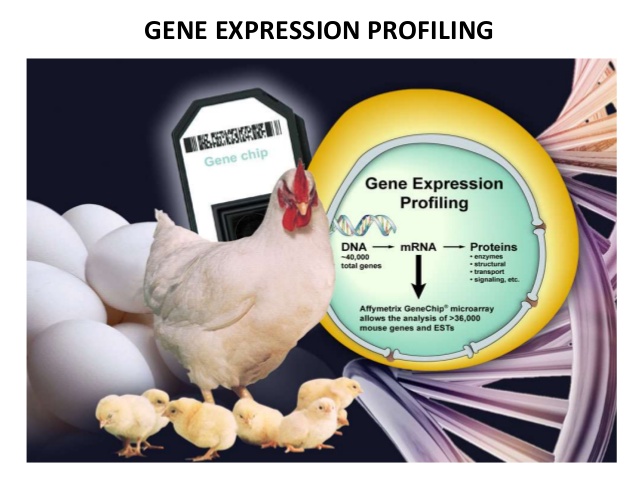
Novel molecular techniques such as microarray technologies have spurred the development of the field of nutrigenomics.
Using microarrays to evaluate gene responses allows us to assess the activity of thousands of genes at the same time, thus allowing a rapid measure of physiological changes. Nutrigenomics can provide a powerful tool for understanding how nutrition impacts performance, health and disease in poultry. This paper will serve as a review of current applications of Nutrigenomics in poultry nutrition. The wealth of information obtained from nutrigenomics studies can help nutritionists and producers better understand how to feed poultry to ensure optimal health and performance.
The use of DNA microarray technology allows us to begin to understand how nutrition modulates gene expression and how this modulation relates to animal health and performance. These molecular technologies also allow for the rapid evaluation of nutritional strategies. Advancements in the area of bioinformatics have enabled investigators to decipher the functional and biological relevance of nutrigenomic data sets. Together, these technological advances are creating new opportunities in poultry research that could lead to improved animal health and production.
Gastrointestinal tract
The avian gastrointestinal tract (GIT) plays a central role in the digestion of feed and absorption of nutrients. Its proper function is essential for optimal health and growth. The GIT not only includes the tissue and cells of the intestine but also the complex community of microbes it harbors. Nutrigenomics can provide a systems biology approach to understanding how nutrients influence intestinal health through interaction with gut cells and the microbiota in the intestine (which in turn can change gut cell dynamics).
Both prebiotics and probiotics can improve gut health resulting in improved feed efficiency and growth in broilers. The cellular mechanisms behind these improvements have been elucidated utilizing nutrigenomics. For example, adding mannan oligosaccharides (MOS) to broiler diets not only increases the expression of mucin, an important component of the protective intestinal mucosal barrier, but also surprisingly down-regulates selected genes involved in cell turnover and proliferation, potentially conferring an energy-sparing effect. Similarly, probiotic bacteria introduced to poultry diets after bacterial challenge have been show to down-regulate selected genes associated with intestinal pathogens.
An even newer area of research that is increasing our knowledge about the interaction of nutrition and GIT health is microbiomics. Microbiomics uses molecular biology techniques, such as advanced DNA sequencing, to study the ecology of the GIT microbial communities. Currently this field is in its infancy and research is limited to general characterization of the unique communities present in each segment of the intestine. Eventually molecular profiling should provide the data needed to equip us to optimize the microbiome through nutrition for improved bird health and production.
Nutrient form versus function
Nutrigenomics can be used to explain why we sometimes see differences between nutrient forms. For example, vitamin E supplementation of broilers is known to confer antioxidant benefits and to improve meat quality and shelf life. Nutrigenomics studies have also shown that vitamin E acts a transcriptional regulator in lipid metabolism and oxidation, helping to further explain its beneficial effects. In other studies, nutrigenomics has been used to determine why different nutrients can sometimes have the same effects on physiological markers. For example, Xiao et al. (2011) showed that a commercial algae-based antioxidant had effects similar to those of vitamin E on total antioxidant status of broilers and meat shelf life. Nutrigenomics data suggest that the antioxidant mimics vitamin E at a transcriptional level by inducing the expression of genes involved in lipid metabolism, cell morphology and cellular oxidation.
Nutrigenomics has also been used to determine the underlying reasons why we see a production response with one nutrient form but not with another (e.g., organic versus inorganic minerals). Hall et al. (2012) found that different forms of zinc can differently regulate the expression of transport proteins in the intestine. For example, Brennan et al. (2011 & 2012) showed that, in both male and female birds, different forms of selenium activate transcription of different functional groups of genes, explaining why organic selenium improves reproduction over inorganic selenium.

Nutritional programming
Over the past several years, researchers have begun to investigate how restricted, “programmed” nutrition during the neonatal and early-life periods can affect animals during adulthood. In chickens, for example, more than 24 h of fasting post-hatch has been shown to have unfavorable effects on weight gain, gut health and meat quality in adult broilers. Conversely, feeding chicks post-hatch diets with reduced protein levels has been shown to benefit bird growth and development throughout adulthood, even after chicks are switched to a traditional diet. Delayed access to feed post-hatch has been shown to alter hepatic gene expression.
Nutrigenomics can help us understand how nutritional programming works by revealing the gene expression patterns associated with early-life nutrition. For example, feeding 100% of the NRC recommendations (normal) for trace minerals for the first 96-h post-hatch can have positive effects on gene expression even after birds are switched to low (20% of the NRC recommendations) mineral diets. In this study, higher levels of minerals fed during the post-hatch period were shown to increase the expression of genes such as Cyclin D1, which play a key role in cell cycle regulation, a biological function essential for gut mucosal growth and repair. The expression of solute carrier proteins, a family of transporters essential for the active and passive transport of nutrients in the small intestine, were upregulated in adult birds that received the normal post-hatch diet, as was the expression of genes involved in the uptake of minerals and other nutrients. In the study by Brennan et al., there was no effect on performance. However, considering the importance of proper intestinal function and health, these changes are considered beneficial. Overall this study demonstrated that post-hatch nutrition can alter gene expression patterns long-term, which can have lifelong implications for bird health.
Commercial applications
We anticipate that the application of nutrigenomics research will lead to the implementation of improved precision feeding strategies by the poultry industry. The gene-level findings of nutrigenomics combined with the performance data (e.g., weight gain, egg production) from whole-animal studies help us to better understand how nutrients affect animal health and production. Nutrigenomics provides a way to identify precisely which nutrients or nutrient combinations are optimal and when they should be delivered to elicit maximum benefits. Through the application of nutrigenomics, we anticipate improved poultry production economics stemming from streamlined feeding strategies, leading to improved feed efficiency and bird health.
References are available on request
From the Australian Poultry Science Symposium
















